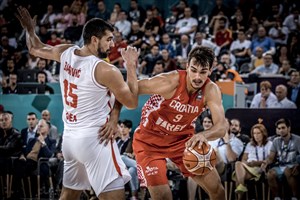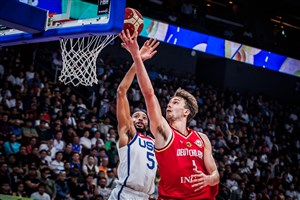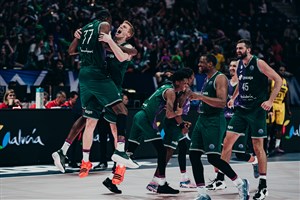
Boomers, Tall Blacks doing it differently
MELBOURNE (Paulo Kennedy’s View from Downunder) – The Tall Blacks have long been known as a team with some of the best ball and player movement in the world of hoops, allowing them to compete with plenty of more highly-credentialed opponents.
As I have written before, the influence of three incredible coaches in Tab Baldwin, Nenad Vucinic and Andrej Lemanis – and others I'm sure – on NZ basketball at both club and international level has been immense, and produced some hoops that has been gorgeous to watch.
With Lemanis taking over the Boomers, Aussie fans got the opportunity to see that sort of free-flowing but clinical execution from the men in green and gold too.
The first time I remember really sitting up and saying wow was the play at the 2:40 mark of the below clip (with a different angle at 3:05), it was a moment of team brilliance that has stuck with me since, and has delivered success internationally and in the NBL.
But that brilliance comes at a price. In three major international tournaments from 2012 to 2016 the Tall Blacks averaged a whopping 16.2 turnovers per game.
Only Iran, Senegal and the Dominican Republic averaged more at Spain 2014. Australia, playing a similar style under Lemanis, averaged the exact same amount of miscues.
Risk and reward
Moving the ball creates great shots, but each exchange increases the likelihood of a mistake. Similarly, moving players is great to open up scoring and offensive rebounding opportunities, but it can also open up the backdoor for opposition fastbreaks.
The story was similar when Henare took over the New Zealand Breakers in the NBL. Last season, his first in charge, the Breakers coughed up a whopping 16.3 topg, coincidentally the same figure as the Tall Blacks and Boomers at the World Cup.
Further to that, the Brisbane Bullets, coached by Lemanis, averaged 16.1 giveaways last NBL season. See the pattern here?
It is a simple case of risk and reward. How much risk are you prepared to take in order for your offence to create open looks?
The response from that has been very different from Lemanis and Henare, both with quality results in different ways.
Lemanis has persisted with his high-exchange system, working to improve how it is executed. We saw the results of that patience in Rio, where the Boomers averaged a remarkable 24.3 assists to just 12.8 turnovers. That’s almost 2:1 for an entire team, a figure that point guards are usually judged by.
Lemanis is developing that system nicely in Brisbane too, shooting an easily league-best 51 per cent from the field while cutting the turnover number down to 12.6.
In contrast, Henare has changed his ways. If you watch the start of the game against France at the 2016 Olympic Qualifying Tournament below, you can see the old New Zealand style still burning strong.
Early up-screens, early post feeds, a lot of cutting action early in the clock and a high-level of passing exchanges in most offences, including quite a few speculators that are either a bucket or a turnover.
It created plenty of shots, but also plenty of errors. There was the feel of past Tall Black teams, but perhaps without the patience and execution with a new generation now in place.
The story was the same with the Breakers last season, Henare’s first in charge. When the offence clicked it was great to watch, and no doubt dizzying to defend.
Too many miscues
But at times the demands of it were too much for the players – the timing had to be spot on, and when it wasn’t simple plays would lead to turnovers.
This was particularly true as fatigue set in, with no better example than that French game. For tired bodies, particularly late in an international tournament, getting through such demanding action can feel like walking in quick sand.
So Henare has adapted his approach. We got the first comprehensive taste of it at the FIBA Asia Cup, where Henare built the New Zealand offence around Shea Ili’s use of the high ball-screen.
A HUGE reason for the @NZBreakers 🔥 start to #NBL18 has been the emergence of backup point guard @shili___, who has raised his game to another level ⤴️
— NBL (@NBL) November 13, 2017
More at ➮ https://t.co/uH4jl4KQ9j #freeili pic.twitter.com/BezF7tnREs
Henare seems to be thinking, ‘Let’s reduce the risk of moving the ball too much and just go straight to exploiting the skills of my team’.
Less early risk taking to get the defence out of position, which teams from Downunder have traditionally excelled in, and more calculated ball movement once the defence is out of position.
It’s a seemingly simple but craftily-developed approach, involving subtle but safe ball movement early in the shot clock, measured off-ball movement by the shooters to take the help away from the ball screen, and then it’s left to their guards to pick their moment to attack.
Not surprisingly, he’s brought that approach to the Breakers this season as well, and they've streaked the league with an 8-1 record based largely around their patience and precision at the offensive end, with their turnover numbers down to 11.6.
Pieces in place
With quality big men in Alex Pledger, Rob Loe, Mika Vukona and Rob Loe rolling or popping, and shooters like Kirk Penney, Tom Abercrombie, DJ Newbill around the perimeter and moving intelligently off the ball on penetration, it’s a good formula.
And then with Ili, Newbill and Dominican Edgar Sosa running the show, they consistently make the right reads of the defence from position one to five.
“They're a high basketball IQ team and they take what the defence opens up for them, whether it’s a drop pass to Pledger rolling for a lay-up or Pledger making the extra pass when our big stepped up,” Boomer and Perth Wildcat Damian Martin said.
.@shili___ picking up where he left off on Thursday night, dropping the delicious dish 🍽 off to @Alex_Pledger #NZLatPER #NBL18 pic.twitter.com/M6xZXbdwyU
— NBL (@NBL) November 12, 2017
Of course, this different approach for the Tall Blacks isn’t just a case of making a change that should have been done years ago, it is a case of finding something that fits the talent and the times.
Where the high-motion, high-exchange system that put New Zealand basketball on the map was well suited to the likes of Penney, Abercrombie, Vukona, Phil Jones, Pero Cameron and Dillon Boucher, the new crew have the speed and skills to play Henare’s way.
Point men
In particular, I’m talking about Ili and Tai Webster, two young point guards who are deadly using the ball-screen and who likely be on the scene for the next two FIBA Basketball World Cups.
That pairing can also execute some of the Tall Blacks’ old-school sets which Henare is still keeping for special occasions, including his ‘head tap’ play which is getting plenty of publicity in the NBL and some other quick-hitting, pass-based variations.
.@Newzilliken dropping the 🔨 like a clumsy tradie off the sweet pass from Kirk Penney #NZLatPER #NBL18 pic.twitter.com/Z7S3mEjLqa
— NBL (@NBL) November 12, 2017
NZ have never had two point guards like this, which is exciting for Kiwi hoops fans, and so is the likelihood most of the in-form Breakers – plus Webster and Isaac Fotu – will be rolling out in Wellington against Korea in next week’s first World Cup qualifier.
The Boomers don’t have the luxury of playing together each week, but the majority of the dominant FIBA Asia Cup team will be on show.
They’ll be daring the Chinese Taipei and Japanese defences to keep up with their unselfish ball movement, the Tall Blacks will be daring Korea and Hong Kong to stop their precise execution.
Two systems developed from the same beginnings, both effective, both great to watch – roll on the qualifiers.
Paulo Kennedy
FIBA
FIBA's columnists write on a wide range of topics relating to basketball that are of interest to them. The opinions they express are their own and in no way reflect those of FIBA.
FIBA takes no responsibility and gives no guarantees, warranties or representations, implied or otherwise, for the content or accuracy of the content and opinion expressed in the above article.
















